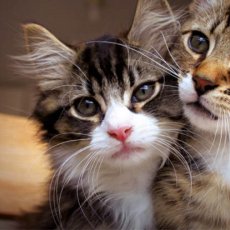By Helen Anne Travis
After Paris Hilton introduced the world to Tinkerbell the Chihuahua on the TV show "The Simple Life," veterinarians say there's been an increased interest in “teacup” dogs - animals bred to be so small they could fit in a designer purse.
But the practices used to breed these tiny dogs could lead to a host of medical problems, and owners should know what they’re getting into before plunking down big bucks for a small dog.
What is a Teacup Dog?
Teacup dogs are animals that have been bred to be as small as humanly - or shall we say caninely - possible. Most dogs considered to be teacups weigh 5 pounds or less, says Los Angeles-based veterinarian Dr. Patrick Mahaney.
You’ll find teacup versions of many already-small dog breeds, including teacup Poodles, teacup Pugs, and teacup Yorkies. Other popular teacup breeds include Maltese, Pomeranians, and Shih Tzus.
To create teacup dogs, breeders pair the so-called “runts” of the litters to make the smallest animal possible, says Dr. Cathy Meeks, a board-certified internal medicine specialist and a group medical director at BluePearl Veterinary Partners in Tampa, Florida. But sometimes the dogs selected for breeding are small because of a birth defect or other medical condition.
“Health risks for these tiny dogs are significant,” says Dr. Judy Morgan, a holistic veterinarian and author of several books. “This is not a natural breeding situation. It is an unnatural practice by breeders looking for a marketing edge.”
The edge comes with a price. Teacup dogs can cost thousands of dollars.
Perceived Advantages of Owning a Teacup Dog
Having a dog that fits in a pocket has potential advantages. You can take them anywhere, they get lots of attention from friends and family and - when they’re healthy - their small statures mean they don’t need large quantities of food and/or preventative medications. This can keep yearly costs low.
Small dogs are also appealing to pet owners who live in facilities with pet size restrictions or can only provide short walks or other forms of exercise.
But doctors say the breeding history of teacup dogs can make these tiny canines more predisposed to certain health issues.
Health Risks for Teacup Dogs
Doctors say common health issues for teacup dogs include hypoglycemia, heart defects, collapsing trachea, seizures, respiratory problems, digestive problems, and blindness.
The breeding practices can also lead to an increased risk for liver shunts, says Meeks. Liver shunts are often congenital birth defects in dogs that affect the liver’s ability to flush out toxins. Treatment for liver shunts can cost up to $6,000, and some types of shunts don’t respond well to therapy regardless of the cost.
Many small dogs are also predisposed to developing dental and gum issues, says Mahaney. Their baby teeth don’t always fall out on their own, and it’s not uncommon for doctors to remove all the baby teeth when the animal is spayed or neutered.
Another size-related health problem is patella luxation, or sliding kneecap, which can affect a teacup dog’s ability to walk. The condition also often makes the animal more prone to arthritis.
In addition, teacup dogs may also be predisposed to developing hydrocephalus, also known as “water on the brain,” says Mahaney.
“When you breed for the way the dog looks instead of for the healthiest genetic stock, health problems emerge,” he adds.
More Potential Dangers for Tiny Teacup Dogs
Owners of these pint-sized pups have to stay vigilant.
If the dogs miss even one meal, their blood sugar levels could drop dangerously low and cause seizures and even death, says Meeks. They also have trouble keeping their bodies warm in cooler weather, which is why you see so many teacup dogs in sweaters.
The dogs’ small bones can break easily, which means owners have to be on alert not to step on them or allow them to jump from too-high surfaces.
“Traumatic events can be life-ending for these dogs,” says Morgan. “Surviving a traffic accident, a fall from the furniture or the owner's arms, or an attack from a larger dog is less likely.”
Teacup dogs’ low blood sugar and body temperature can also lead to problems in the operating room. Doctors have to make sure the operation doesn’t outlast the animal’s blood sugar reserves or provide them with the necessary supplements. They also have to work hard to keep the animal warm as body temperature drops under anesthesia.
“They’re harder to treat,” says Meeks. “Can you imagine putting an IV in a 3 pound dog?”
Meeks says she would prefer if breeders stopped trying to create the miniature pups because of their potential health problems. But if pet owners absolutely have to have one, they need to make sure they’re working with a reputable breeder or rescue group.
You have to do your homework to find the healthiest animal possible, says Mahaney.
“Nobody likes to see a pet suffer and no one likes to see an owner struggle under the cost of medical care,” he says. “I think there are healthier options out there.”








 Vectora Design
Vectora Design